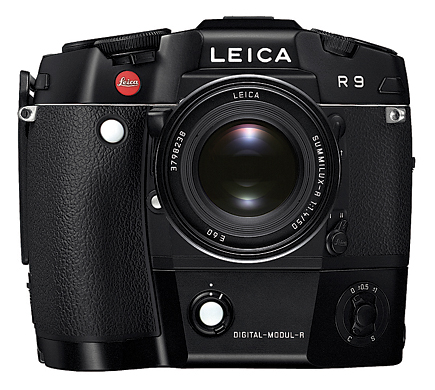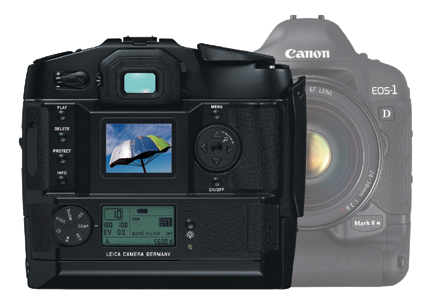Leica’s DIGITAL-MODUL-R; Powerful, But Pricey Leica SLR Digital Back Arrives
At PMA 2004 I handled a prototype of Leica's DIGITAL-MODUL-R and was immediately impressed by the concept of being able to convert a film camera into digital by merely switching backs. At PhotoPlus Expo later that year I had the chance to see a preproduction model and hoped that someday this wonderful product would see the light of day. Recently, I've been shooting with a production DIGITAL-MODUL-R and there is much to admire about the skill and finesse in which this clever design has been executed.
 |
An Engineering Marvel
The Leica DIGITAL-MODUL-R is a brilliantly engineered and constructed product
that, given its goals, could hardly have been accomplished better. Think about
it: Here is the holy grail of imaging: an accessory that converts a 35mm film-based
SLR into a digital SLR. Ya gotta wonder why the Japanese manufacturers never
tried it. Simple--it involves lots of compromises, not something that the
boys from Solms are used to but if you are a fan of the incomparable Leica optics,
it's the only game in town.
Let's start with the good stuff. The DIGITAL-MODUL-R is compatible with
any Leica R8 or R9 and these two SLRs will work with any of the high-performance
lenses from the Leica R-System that were made after 1965 to produce digital
or film images. Leica's digital back--it's more than just a
back as you will see--was developed in collaboration with Imacon, a company
well-known for high-end scanners and medium format digital camera backs.
 |
|
|
The DIGITAL-MODUL-R's imaging chip (26.4x17.6mm) produces 10-megapixel
resolution image files and is protected by a thin layer of glass that uses a
microlens structure. No anti-alias filter is used because it might reduce image
definition. Potential moiré effects are handled by the camera's
software that can be turned off or on, not that I noticed any difference. The
back, let's just call it that since everybody else will, has a low focal
length extension factor of 1.37x, and lets you shoot sequences of up to two
frames a second. ISO speeds between 100 and 1600 are available.
The DIGITAL-MODUL-R uses Secure Digital memory cards and Leica includes a SanDisk
256MB Ultra II card in the package. The maximum capacity of Secure Digital media
is currently stuck at 2GB and Lexar only offers a 1GB card, although it includes
a lifetime warranty. Capture formats include TIFF, JPEG, and raw, although Leica
(like Hasselblad) adopted the Adobe Digital Negative (DNG) standard. A FireWire
connection is provided for those few users who want to directly connect the
camera to a computer instead of using a card reader. Power is supplied by a
dedicated lithium ion battery that appears identical to one used in the R8/R9
motor drive and never let me down.
All key digital parameters are set with a central dial-in combination with clearly
laid out menus that appear on the smallish 1.8" LCD display. Because,
Leica says, "the R8 and R9 were already designed to work with digital
solutions" the digital back communicates with the camera's standard
controls and fits smoothly into the traditional way of operating the camera.
Menus are only needed for "customer preferences" such as the aforementioned
moiré filter, color space (Adobe RGB or sRGB), histogram, and similar
incidental predilections. One push of the Info button calls up all the key data
of an exposure such as histogram and warnings. Additionally, all overexposed
("clipped") areas of the image are displayed graphically.
 |
|
|
Out Here In The Real World
While aficionados may cry foul about comparing any Leica to any contemporary
camera--film or digital--that's exactly what I'm about
to do, so get over it.
The Leica R8 and R9 appear to be as big as medium format cameras, but I own
an R8 and love using it because of its precision. I was surprised to see that
the R9 with DIGITAL-MODUL-R attached is smaller than a Canon EOS-1D Mark II
N. The big difference is weight: the R9/DIGITAL-MODUL-R package weighs in at
over 3 lbs; the Canon is 2.64 lbs. Canon gets the nods in ergonomics, too. Using
the R8/R9 can be an acquired taste, but the backhanded compliment is that it's
not as awkward to use as it looks. Forget the wrist strap. Unless you have fingers
like Eubie Blake or Arthur Rubinstein, you won't be able to reach the
shutter release if you use it.
- Log in or register to post comments

































